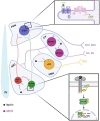Neuronal primary cilia integrate peripheral signals with metabolic drives
- PMID: 37064917
- PMCID: PMC10090425
- DOI: 10.3389/fphys.2023.1150232
Neuronal primary cilia integrate peripheral signals with metabolic drives
Abstract
Neuronal primary cilia have recently emerged as important contributors to the central regulation of energy homeostasis. As non-motile, microtubule-based organelles, primary cilia serve as signaling antennae for metabolic status. The impairment of ciliary structure or function can produce ciliopathies for which obesity is a hallmark phenotype and global ablation of cilia induces non-syndromic adiposity in mouse models. This organelle is not only a hub for metabolic signaling, but also for catecholamine neuromodulation that shapes neuronal circuitry in response to sensory input. The objective of this review is to highlight current research investigating the mechanisms of primary cilium-regulated metabolic drives for maintaining energy homeostasis.
Keywords: BBSome; hypothalamus; intraflagellar transport; metabolism; obesity; primary cilium.
Copyright © 2023 DeMars, Ross, Starr and McIntyre.
Conflict of interest statement
The authors declare that the research was conducted in the absence of any commercial or financial relationships that could be construed as a potential conflict of interest.
Figures


Similar articles
-
Whole-Organism Developmental Expression Profiling Identifies RAB-28 as a Novel Ciliary GTPase Associated with the BBSome and Intraflagellar Transport.PLoS Genet. 2016 Dec 8;12(12):e1006469. doi: 10.1371/journal.pgen.1006469. eCollection 2016 Dec. PLoS Genet. 2016. PMID: 27930654 Free PMC article.
-
Specialized Cilia in Mammalian Sensory Systems.Cells. 2015 Sep 11;4(3):500-19. doi: 10.3390/cells4030500. Cells. 2015. PMID: 26378583 Free PMC article. Review.
-
Primary cilia in energy balance signaling and metabolic disorder.BMB Rep. 2015 Dec;48(12):647-54. doi: 10.5483/bmbrep.2015.48.12.229. BMB Rep. 2015. PMID: 26538252 Free PMC article. Review.
-
Peripheral and central control of obesity by primary cilia.J Genet Genomics. 2023 May;50(5):295-304. doi: 10.1016/j.jgg.2022.12.006. Epub 2023 Jan 9. J Genet Genomics. 2023. PMID: 36632916 Review.
-
Seriously cilia: A tiny organelle illuminates evolution, disease, and intercellular communication.Dev Cell. 2023 Aug 7;58(15):1333-1349. doi: 10.1016/j.devcel.2023.06.013. Epub 2023 Jul 24. Dev Cell. 2023. PMID: 37490910 Free PMC article. Review.
Cited by
-
Primary cilia in Parkinson's disease: summative roles in signaling pathways, genes, defective mitochondrial function, and substantia nigra dopaminergic neurons.Front Aging Neurosci. 2024 Sep 18;16:1451655. doi: 10.3389/fnagi.2024.1451655. eCollection 2024. Front Aging Neurosci. 2024. PMID: 39364348 Free PMC article. Review.
-
Postnatal Dynamic Ciliary ARL13B and ADCY3 Localization in the Mouse Brain.Cells. 2024 Jan 30;13(3):259. doi: 10.3390/cells13030259. Cells. 2024. PMID: 38334651 Free PMC article.
-
Ciliogenesis defects after neurulation impact brain development and neuronal activity in larval zebrafish.iScience. 2024 May 22;27(6):110078. doi: 10.1016/j.isci.2024.110078. eCollection 2024 Jun 21. iScience. 2024. PMID: 38868197 Free PMC article.
-
The Primary Cilium and its Hedgehog Signaling in Nociceptors Contribute to Inflammatory and Neuropathic Pain.Res Sq [Preprint]. 2024 Feb 26:rs.3.rs-3812442. doi: 10.21203/rs.3.rs-3812442/v1. Res Sq. 2024. PMID: 38464172 Free PMC article. Preprint.
-
The Nociceptor Primary Cilium Contributes to Mechanical Nociceptive Threshold and Inflammatory and Neuropathic Pain.J Neurosci. 2024 Nov 20;44(47):e1265242024. doi: 10.1523/JNEUROSCI.1265-24.2024. J Neurosci. 2024. PMID: 39349056 Free PMC article.
References
-
- Alhassen W., Kobayashi Y., Su J., Robbins B., Nguyen H., Myint T., et al. (2022). Regulation of brain primary cilia length by MCH signaling: Evidence from pharmacological, genetic, optogenetic, and chemogenic manipulations. Mol. Neurobiol. 59 (1), 245–265. 10.1007/s12035-021-02511-w - DOI - PMC - PubMed
Publication types
Grants and funding
LinkOut - more resources
Full Text Sources
Research Materials

